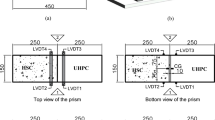Abstract
In service, reinforced concrete structures undergo various stresses inducing cracks. These cracks provide a preferential path for water and aggressive agents penetration into concrete, which compromises the structural durability by accelerating concrete and steel reinforcement deterioration. In this context, durability of cracked concrete has become an important research topic and can be studied through the permeability of concrete. This research project focuses on the influence of the fiber content and steel reinforcement ratio on the water permeability of reinforced concrete. Water permeability tests were carried out simultaneously with a uniaxial tensile loading applied on reinforced concrete prisms made of high performance concrete (HPC), high performance fiber reinforced concrete (HPFRC) and ultra high performance fiber reinforced concrete (UHPFRC). In service conditions, permeability is reduced by 31, 92 and 99 % for fiber contents of 0.75 % (HPFRC), 1.5 % (HPFRC) and 2 % (UHPFRC) respectively compared with conventional HPC. The increase of steel reinforcement ratio from 1.23 to 2.47 % reduced the permeability by 70 % at service loading.










Similar content being viewed by others
References
Abbas A, Carcassès M, Ollivier JP (2000) The importance of gas permeability in addition to the compressive strength of concrete. Mag Concr Res 52(1):1–6
ACI (2003) Building code requirements for structural concrete (ACI 318-02) and commentary (ACI 318R-02). American Concrete Institute, Detroit
Akhavan A, Shafaatian S-M-H, Rajabipour F (2012) Quantifying the effects of crack width, tortuosity, and roughness on water permeability of cracked mortars. Cem Concr Res 42(2):313–320
Aldea CM, Shah SP, Karrr A (1999) Permeability of cracked concrete. Mater Struct 32:370–376
ASTM (2010) Standard test method for static modulus of elasticity and poisson’s ratio of concrete in compression ASTM C469/C469M. American Society for Testing and Materials, ASTM International, West Conshohocken
ASTM (2012) Standard test method for compressive strength of cylindrical concrete specimens ASTM C39/C39M. American Society for Testing and Materials, ASTM International, West Conshohocken
BAEL (1999) Règles BAEL 91 modifiées 99 - Règles techniques de conception et de calcul des ouvrages et constructions en béton armé suivant la méthode des états-limites. Eyrolles, édition 2000–333 pages, pp 45–47
Beaurivage F (2009) Étude de l’influence des paramètres structuraux sur les lois de comportement des bétons fibrés pour la conception de structures. École Polytechnique de Montréal, Montréal
Bischoff PH (2001) Effects of shrinkage on tension stiffening and cracking in reinforced concrete. Can J Civ Eng 28(3):363–374
Breysse D, Gérard B (1997) Transport of fluids in cracked media. In: Reinhardt HW (ed) Rilem Report 16—Penetration and permeability of concrete: barriers to organic and contaminating liquids, vol 16. E & FN Spon, Stuttgart, pp 123–154
Charron J-P, Denarié E, Brühwiler E (2008) Transport properties of water and glycol in an ultra high performance fiber reinforced concrete (UHPFRC) under high tensile deformation. Cem Concr Res 38(5):689–698
Charron JP, Denarié E, Brühwiler E (2007) Permeability of ultra-high performance fiber reinforced concretes (UHPFRC) under high stresses. Mater Struct 40(3):269–277
CSA (2009) Concrete materials and methods of concrete construction CAN-CSA A23.1-09. Canadian Standards Association, Mississauga, Ontario, Canada
Darcy H (1856) Détermination des lois d’écoulement de l’eau à travers le sable, Appendix, note D. Les fontaines publiques de la ville de Dijon. Victor Dalmont, Paris, pp 590–594
Desmettre C, Charron JP (2011) Novel water permeability device for reinforced concrete under load. Mater Struct 44(9):1713–1723
Desmettre C, Charron JP (2012) Water permeability of reinforced concrete with and without fiber subjected to static and constant tensile loading. Cem Concr Res 42:945–952
Desmettre C, Charron JP (2013) Water permeability of reinforced concrete subjected to cyclic tensile loading. ACI Mater J 110:79–88
Fields K, Bischoff PH (2004) Tension stiffening and cracking of high-strenght reinforced concrete tension members. ACI Struct J 101(4):447–456
Hoseini M, Bindiganavile V, Banthia N (2009) The effect of mechanical stress on permeability of concrete: a review. Cem Concr Compos 31(4):213–220
Kollek JJ (1989) The determination of the permeability of concrete to oxygen by the Cembureau method—a recommendation. Mater Struct 22(3):225–230
Lawler JS, Zampini D, Shah SP (2002) Permeability of cracked hybrid fiber-reinforced mortar under load. ACI Mater J 99:379–385
Lawler JS, Zampini D, Shah SP (2005) Microfiber and macrofiber hybrid fiber-reinforced concrete. J Mater Civ Eng 17(5):595–604
Ludirdja D, Berger RL, Young JF (1989) Simple method for measuring water permeability of concrete. ACI Mater J 86(5):433–439
Mivelaz P (1996) Etanchéité des structures en béton armé, fuites au travers d’un élément fissuré. École Polytechnique Fédérale de Lausanne, Lausanne
Naaman AE (2008) High performance fiber reinforced cement composites. In: Caijuin S, Mo Y-L (eds) High-performance construction materials: science and applications. Engineering materials for technological needs, vol 1. World Scientific Publishing Company, Singapore, pp 91–153
Neville AM (1996) Properties of concrete, 4th edn. Wiley, New York
Picandet V, Abdelhafid K, Hervé B (2009) Crack effects on gas and water permeability of concretes. Cem Concr Res 39:537–547
Powers TC, Copeland LE, Hayes JC, Mann HM (1954) Permeability of Portland cement paste. J Am Concr Inst 26(3):285–298
Rapoport J, Aldea C, Shah S, Ankenman B, Karr A (2002) Permeability of cracked steel fiber-reinforced concrete. J Mater Civ Eng 14(4):355–358
RILEM (2003) Final recommendation of RILEM TC 162-TDF: test and design methods for steel fibre reinforced concrete sigma-epsilon-design method. Mater Struct 36(262):560–567
Wang K, Jansen DC, Shah SP, Karr AF (1997) Permeability study of cracked concrete. Cem Concr Res 27(3):381–393
Acknowledgments
This research project has been financially supported by the Québec Research Fund on Nature and Technologies (FQRNT) and by the Natural Sciences and Engineering Research Council (NSERC). The authors are grateful to Holcim, Bekaert, Euclid and Sika for their material donations for achieving this research project.
Author information
Authors and Affiliations
Corresponding author
Rights and permissions
About this article
Cite this article
Hubert, M., Desmettre, C. & Charron, JP. Influence of fiber content and reinforcement ratio on the water permeability of reinforced concrete. Mater Struct 48, 2795–2807 (2015). https://doi.org/10.1617/s11527-014-0354-z
Received:
Accepted:
Published:
Issue Date:
DOI: https://doi.org/10.1617/s11527-014-0354-z




